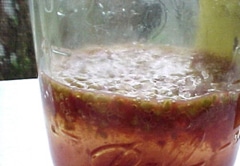Updated: March 19, 2020
Fermenting tomato seeds is no easy task. That said, the majority of seed saving experts maintain that you should ferment tomato seeds before storing them for the winter.
But there’s no need.
Table of Contents
This is a long, detailed article. You can jump to where you want to be by clicking on the different sections below. To come back to this table of contents, just use the back button on your browser.
Why ferment tomato seeds?
For those of you who are not familiar with the process of fermenting tomato seeds, it involves:
- Squeezing the guts and seeds of your best tomato into a container
- Covering the tomato material with water
- Letting the mixture set until mold grows on the top
The purpose of this sometimes smelly process is to have the microorganisms eat the gelatinous material that surrounds the seeds. As I said, no easy task.
The stuff surrounding the seeds actually inhibits germination. It prevents the seeds from germinating while they are still in the tomato.
Experts also claim that the fermentation process prevents tomato diseases in some way.
Let’s take a sec to get the legal words out of the way. This article may contain affiliate links. That means if you click and buy from my partners, I will make a tiny amount of money. This in no way affects my recommendations.
I’ve had great success saving tomato seeds without fermenting. I just remove the seeds and smear them on a paper towel.
Germination rates when I use this methods are very high. Some of my best plants started this way.

you must ferment tomato seeds?
It’s possible that my “paper towel” success is due to the variety of tomato. It could be the anti-germination material of my pink brandywines or pineapple tomatoes isn’t as potent as it would be in other varieties.
Fermenting tomato seeds … or not
To see if fermenting actually makes a difference, I tested both methods. This is what I did:
- Split a tomato and made two batches
- Dried batch one (without fermentation) on a paper towel
- Fermented and dried batch two using the traditional method
- Planted seeds from both batches in seed starting mix in different paper pots
- Compared seed germination rates and plant health from both batches
Related: Paper Pots Versus Soil Blocks. Which is Better for Starting Seeds?
I tested my pink brandywines and was amazed at the results.
The unfermented seeds germinated as well as the fermented batch. In fact, unfermented seeds actually had consistently higher rates of germination.
They also took less time to sprout. With both methods, damping off was not a problem.
Not exactly scientific
Now, I’ll be the first to tell you that this was NOT a truly scientific test. There are many reasons why the results may be erroneous. For example, the fermented seeds:
- Might have been bad even before they were fermented
- Could have received too little moisture during germination
- May have been planted too deeply
You should consider my test a data point and not the complete answer to the question of whether to ferment or not. Still, it provides important evidence that there may not be any advantage to fermentation.
Do you ferment your tomato seeds before saving them? Let us know your method by commenting below.
Related articles you might enjoy:
- Book Review: Jere Gettle’s The Heirloom Life Gardener
- Free 30-page Seed Saving Guide
- Rare Vegetable Seeds Free from U.S. Government
- The Best Way to Save Tomato Seeds
Suburban Hobby Farmer is a participant in the Amazon Services LLC Associates Program, an affiliate advertising program designed to provide a means for sites to earn advertising fees by advertising and linking to amazon.com.
